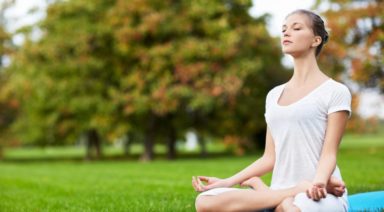Harvard Meditation Study: Resilience, Tummo, and Inner Peace

Long before Harvard’s recent studies on meditation and mindfulness, the science around the subject has been disputed. Regardless, meditation lovers, mindfulness experts, monks and prayerful people of all types regularly report a variety of benefits resulting from these practices.
Whether avid meditators or not, most of us have reported positive experiences when meditating. Benefits include stress reduction, feeling more peaceful, feeling better about ourselves, feeling less judgmental, and improved relationships and creativity.
Many couples who meditate together report feelings of deepening and connectedness that were not present before meditation. Teachers who introduce meditation to their students find that everyone has better attention spans and the majority tend to get along better.
Many doctors report that mindfulness techniques and positive visualizations help to calm their patients. Some doctors have said that regimens of meditation have improved conditions associated with irritable bowel syndrome, fibromyalgia, psoriasis, anxiety, depression, and post-traumatic stress disorder.
Meditation and mindfulness are taught and practiced by prisons, sports teams and even the U.S. military to improve resilience, clarity, presence of mind, and feelings of connectedness.
Also, the vast majority of meditation studies have shown that meditators tend to experience regular states of selflessness and emotional clarity.
“The real meditation is how you live your life.”
— Jon Kabat-Zinn
“Surrender to what is. Let go of what was. Have faith in what will be.”
— Sonia Ricotti
The Science of Meditation
Traditionally, meditation and mindfulness studies have been poorly designed and executed. Of the over 400 clinical trials aimed at determining the benefits of meditation between 1956 and 2005, only 10% were constructed from quality theoretical perspectives and methodologies. This included studies by the National Center for Complementary and Integrative Health (NCCIH) and the American Heart Association.
When it comes to happiness and emotional well-being, some studies show that people who meditate have higher levels of happiness than control groups. Similar studies have shown that people who meditate for 20 minutes per day have higher levels of happiness than those who rested for 20 minutes per day. The challenge with these types of results is that they haven’t included data related to meditators being better at self-care than non-meditators.
“The present moment is filled with joy and happiness. If you are attentive, you will see it.”
— Thich Nhat Hanh
The Harvard Study on Meditation and Mindfulness
A neuroscientist at Harvard Medical School and Massachusetts General Hospital, Sara Lazar, sought to explore the benefits of meditation and mindfulness via brain scans.
What did she learn? Meditation and similar practices can improve, expand and change your brain. Lazar’s findings of meditators were profound:
- Over time, their senses become enhanced.
- With regular meditation, they experience improved executive decision making. Whether younger or older, participants have shown increased gray matter in the prefrontal cortex.
- The brains of new meditators thickened after eight weeks in the areas of the brain that cater to self-relevance, learning, cognition, memory, emotional regulation, adopting perspectives, empathy, compassion and the production of regulatory neurotransmitters.
- The areas of the brains of new mediators related to anxiety, fear, and stress became smaller over time.
While there isn’t robust data about how much and how long someone must meditate to achieve benefits like these, Lazar said that meditators would probably need to practice at least a couple of days per week, at an average of 30 minutes per day. That said, there is no definitive scientific data in this area.
Tummo Meditation
While meditation science has been unable to prove every benefit for every niche and category, Tibetan Monks and Himalayan yogis have been meditating for centuries, and with consistent, miraculous results.
Tummo Meditation, (gTum-mo in Tibetan, or g-Tummo), which translates to “inner fire,” is regularly taught and practiced by Tibetan Buddhists throughout the world.
Wrapped in cold, wet sheets, Himalayan monks can heat their bodies through Tummo meditation, and in the process, dry the wet sheets. This astounding ability has kept academics, doctors and regular folks stupefied for over a century. Truly, Tummo meditation is the holy grail of meditation neuroscience.
This ancient technique combines meditative breathing with visualization and results in a deep state of inward connection. Monks report being able to increase and control the heat in their bodies.
While their body temperatures rise during the meditation, they can transfer the resulting heat to any organ or extremity, including their scalps, hearts, kidneys, fingers, and toes.
Tummo meditators report a variety of benefits, including improved concentration, memory, and mental clarity; improved breathing, including the depth of breaths; improved lung and heart health; improved confidence; and of course, improved control over the body’s heat
Given all this, meditation should be a no-brainer, right? RIGHT!
How To Tummo
The purpose of Tummo is to reach a high yoga tantra (or state) and gain control over the body’s processes.
Here are the steps to achieving Tummo Meditation and the psychic control of your body’s heat:
- Sit comfortably, with your back straight; cross-legged is ideal.
- Imagine your spirit’s kundalini (channel) “tube” up and down your spine.
- Imagine that each nostril is a tube connected to your kundalini tube.
- Imagine your body to be hollow, sacred and filled with light.
- Visualize a hot ball of fire inside of your body, around the belly-button.
- Focus on your breath and inhale slowly.
- Imagine each breath to feed your fireball of light, making it hotter and hotter.
- Imagine that your fireball is safe and healing, continuing to feed it with breath.
- Try to hold each breath for 10-30 seconds, then exhale.
- You can repeat this breathing process for up to 30 minutes.
“What day is it?” asked Pooh. “It’s today,” squeaked Piglet. “My favourite day,” said Pooh.
— A.A. Milne
Types of Meditation and Mindfulness
Meditation can take many forms. Some meditate on their breath. Others find that mantras and tones are helpful when attempting to detach from the mind and be fully in the present moment.
Here are a few types of meditation that you might find helpful.
Mindfulness Meditation (also Breath Meditation)
- Sit comfortably with your back straight
- Focus on your breath and how it moves in and out of your body. Feel the sensations in your lungs, chest, and belly. Notice the air as it enters your nose and mouth. Pay attention to your breath as it leaves your body.
- Allow thoughts to come and go. Become the watcher of your thoughts, whether they are based in happiness, hope or anxiety. Simply allow them to be and then let them go. Remain calm as you feel the results of your thoughts. Refrain from suppressing or ignoring them. Over time, your thoughts will naturally bubble up and disappear at will.
- Without judging yourself, allow your mind to wander or get carried off into a thought-path. When this happens, effortlessly return your focus to your breath. Throughout the process, be gentle with yourself.
- When you experience a period of peacefulness, try to maintain it.
- When the time feels right, bring your meditation to a close. As you come out of the meditation, sit quietly for some time. Become aware of who you are in the moment, and where you are. Be gentle with yourself as you return to the present moment.
- When it feels right to you, stand up and carry on with your day.
Mantra or Tone Meditation
- Once you’re seated comfortably, either in a chair or in lotus position on the floor, choose a mantra or tone for inhaling and exhaling.
- As you inhale, silently chant the tone “Maaaaa” in your mind.
- As you exhale, silently chant the tone “Ommmmm” in your mind.
- Throughout the meditation, allow your attention to return to these tones continually.
- When we tone within our minds, we dissolve our mental chatter and bring healing vibrations to our brains, hearts, and bodies.
Start with 5 minutes each morning and try to increase the length of time every day.
Meditation in Action
Whether we are exercising, walking or doing the dishes, an activity can quickly become a meditation. Focus on your feet pressing against the Earth or your hands stretching out as they touch a tree. Bring your attention to the activity, without judgment, anticipation or stress. See things as they really are, without trying to reduce them to something else. Bring your mind’s attention to the resulting sensations within each activity.
This type of meditation allows us to detach from our minds and identities, and immerse ourselves in the spirit of the action. Throughout the process, we experience moments of liberation.
There are many types of meditation. You might consider studying the true nature of reality through Vipassana Meditation, a 10-day silent retreat.
Research what feels best to you and try to build meditation into your daily habits and routines.
Ongoing Scientific Efforts
Research perspectives and methodologies aimed at proving the benefits of meditation and mindfulness have drastically improved.
Thankfully, an ongoing effort in this area is occurring at a variety of universities and hospitals, including, but certainly not limited to:
- Massachusetts General Hospital’s Benson-Henry Institute
- Brigham and Women’s Hospital’s Osher Center for Integrative Medicine
- The Cambridge Health Alliance
- Harvard University
- The Mindfulness Research Collaborative
- University of Vermont
- University of Miami
- Georgetown University
- Stanford Center for Integrative Medicine
- Global Center for Academic and Spiritual Life
- Many other institutions and organizations
Mindfulness Leaders
Thich Nhat Hanh, the renowned Tibetan Buddhist monk, taught thousands of people how to meditate. Jon Kabat-Zinn, his worthy student, memorialized those teachings in a variety of profound books on the subject, including “Wherever You Go, There You Are,” “Mindfulness For Beginners,” and “Meditation is Not What You Think.”
Jon Kabat-Zinn is the founder of MBSR (mindfulness-based stress reduction) and the creator of the Stress Reduction Clinic and the Center for Mindfulness in Medicine, Health Care, and Society at the University of Massachusetts Medical School.
10 Fun Facts About Breathing & the Respiratory System

Our ability to breathe is fascinating, as it’s one of the only systems in our body that can be controlled both voluntarily, through the central nervous system, and more often involuntarily, through the autonomic nervous system. This overlap between the two systems is the reason why focused, intentional breathing methods through yoga and meditation are able to affect other involuntary muscles like the heart.
Our breath is what gives us life and without it, the human body cannot exist. But is it possible to better your life by paying more attention to how you breathe?
While breathing is so commonplace to our existence, proper breathing techniques and awareness of breath can have dramatic implications on our health. Having knowledge of specific breathing techniques can lower stress, help you sleep, help your mind function more acutely, and even curb food cravings.
When we breathe, the average adult draws in about 13 pints of air into the lungs every minute. From the lungs, that oxygen is then transferred from the air sacs in our lungs throughout the body via red blood cells to the blood vessels that distribute it to nearly every system. Meanwhile, waste gases, like CO2, are exchanged and filtered out.
For the average person with good lung health, the amount of oxygen in the blood, or the arterial blood gas (ABG) oxygen level, should be somewhere between 95-100 percent oxygen.
















